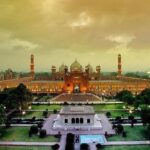

Overview
Swat District, also called Swat Valley, is in the Malakand Division of Khyber Pakhtunkhwa, Pakistan. Famous for its natural beauty, it is a top tourist spot with a population of 2.68 million (2023 census). The valley, centered around the Swat River, was once a hub of Gandharan Buddhism but became predominantly Muslim after the 16th-century Yousafzai conquest. Swat later became an independent state in the 19th century and a princely state under British rule in 1918.
Map
Info
Swat Valley, Pakistan – The Switzerland of the East
Swat Valley, located in the Khyber Pakhtunkhwa province of Pakistan, is a breathtakingly beautiful region known for its lush green valleys, snow-capped mountains, and rich cultural heritage. Often called “The Switzerland of the East,” Swat attracts tourists from all over the world for its natural beauty, historical sites, and adventure opportunities.
Key Highlights
- Location: Situated in the Malakand Division of Khyber Pakhtunkhwa, Swat lies along the banks of the Swat River.
- Altitude: Ranges from 2,000 feet in the plains to over 7,500 feet in the mountainous areas.
- Language: The main language is Pashto, though Urdu and English are widely understood.
- Climate: Pleasant summers with mild temperatures and cold, snowy winters.
Historical and Cultural Significance
- Swat has a history dating back over 2,000 years and was once a hub of the Gandhara civilization, known for its Buddhist heritage.
- It was a significant center of Buddhist learning and pilgrimage, with many stupas, monasteries, and artifacts.
- The valley also has historical links to Alexander the Great, whose armies passed through this region.
Top Tourist Attractions
- Malam Jabba: Pakistan’s premier ski resort, offering skiing, snowboarding, and chairlift rides.
- Kalam Valley: A serene destination known for its rivers, pine forests, and alpine meadows.
- Mahodand Lake: A crystal-clear glacial lake surrounded by majestic peaks.
- Ushu Forest: Dense pine forests offering scenic views and a peaceful retreat.
- Bahrain: A bustling town famous for its bazaars, riverside hotels, and cool weather.
- Fizagat Park: A family-friendly park near Mingora with stunning views of the Swat River.
Buddhist Heritage
- Butkara Stupa: One of the oldest Buddhist stupas in the region, dating back to the 3rd century BCE.
- Jahanabad Buddha: A giant rock-carved statue of Buddha, reflecting the valley’s ancient Buddhist history.
- Saidu Sharif Museum: Displays artifacts from Swat’s Buddhist and Gandhara periods.
Natural Beauty and Adventure
- Swat River: Flows through the valley, offering opportunities for fishing and white-water rafting.
- Trekking: Trails like the trek to Kandol Lake or Spin Khwar Lake attract adventurers.
- Wildlife: Home to snow leopards, markhors, and various bird species.
Local Culture and Festivals
- The people of Swat are known for their hospitality, colorful attire, and traditional dances.
- Festivals like Jashn-e-Swat celebrate the valley’s culture, featuring music, sports, and food.
Access and Accommodation
- By Road: Accessible from major cities like Islamabad and Peshawar via the Swat Expressway.
- By Air: Flights operate to Saidu Sharif Airport.
- Hotels and Resorts: Options range from luxury resorts to budget accommodations.
Modern Developments
- Swat has made significant strides in infrastructure and tourism facilities after a period of turmoil in the late 2000s.
- The region is now peaceful and welcoming, with improved roads, hotels, and amenities.
Swat Valley is a treasure trove of natural beauty, adventure, and history. Whether you’re looking for a peaceful getaway, thrilling adventures, or a deep dive into ancient cultures, Swat has something for everyone.


